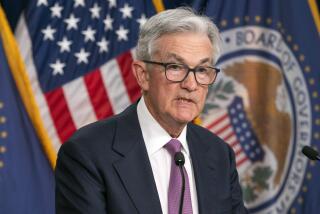Fed, worried about job growth, launches new stimulus
WASHINGTON -- The Federal Reserve, hoping to give another shot in the arm to the pallid recovery, announced it would launch a new round of a controversial bond-buying stimulus program. The central bank also further extended its pledge to keep short-term interest rates near zero, now through the middle of 2015.
The widely expected Fed actions, unveiled Thursday after a two-day policy meeting here, are aimed at driving down interest rates to boost investment and spending, thereby spurring economic growth and in particular the sluggish job market.
“The [policymaking] committee is concerned that, without further policy accommodation, economic growth might not be strong enough to generate sustained improvement in labor market conditions,” the Fed said in a statement.
LIVE VIDEO DISCUSSION: Join us at 1 p.m. today
Stocks jumped on word of the new stimulus. The announcement capped days of anticipation on Wall Street that the Fed -- which had been hinting for some weeks that it was preparing to act -- would again ride to the rescue.
But it’s unclear what effect the new action will have, and the move puts Fed Chairman Ben S. Bernanke in the cross hairs of congressional Republican leaders and GOP presidential nominee Mitt Romney as the stimulus comes just weeks before the election. Romney and others have opposed further monetary stimulus for the economy, warning of the risks of inflation and asset bubbles.
Under the new stimulus plan, known technically as quantitative easing, the Fed would begin buying $40 billion worth of mortgage-backed securities a month. Unlike its previous two rounds of bond-buying, the central bank left open the overall amount it would purchase, giving policymakers flexibility to extend or pull back on purchases depending on the program’s effect on the economy.
Combining the new bond buying with previously existing programs, the Fed said it would increase the central bank’s holdings of longer-term securities by about $85 billion a month through the end of the year.
In opting to buy mortgage-backed securities instead of Treasury bonds, which was the focus of its second round of quantitative easing, the Fed is targeting the housing market, which is finally showing some signs of life but remains depressed. Bernanke and his colleagues are betting that they can further push down already historically low mortgage rates, in a bid to stimulate more home sales and refinancings.
But it remains to be seen just how much punch the new stimulus will have. Bernanke has defended the Fed’s previous bond-buying efforts, citing a “substantial” body of research suggesting that the purchases had reduced home-loan rates, lifted stock prices and generally eased financial conditions for investors and consumers.
“At some level, the Fed has hit decreasing returns on these things,” said Arvind Krishnamurthy, a Northwestern University finance professor who studied the effect of the first two rounds of the Fed’s bond buying. “No matter what they do, the impact is going to be smaller. That’s not to say it’s not going to have an impact. I think it will have an impact.”
He said the Fed’s purchases of mortgage-backed securities have had more spillover effect on household and corporate borrowing rates than its buying of Treasury notes. This new round could take mortgage rates -- 3.55% for the average 30-year fixed loan this week -- down another 0.25 percentage points, he said.
That will allow more homeowners to refinance at lower rates, Krishnamurthy said, although he noted that only a fraction of households can refinance.
Critics have warned that the Fed’s continued easy-money policies are setting up the economy for runaway inflation in the future, something that Bernanke does not see happening. The policy statement Thursday said inflation has been “subdued” and that the committee anticipates inflation to run at or below its 2% target over the next few years.
The Fed’s bond-buying programs, which have more than tripled the central bank’s balance sheet to $2.8 trillion over the last four years, and its other efforts to help the economy have prompted lawmakers to press to audit the Fed and have pushed the traditionally secretive institution to be more transparent.
Bernanke himself has raised questions about the potential benefits -- and risks, economically and politically -- of additional quantitative easing. But he apparently has concluded that it’s worth a try, especially given the ongoing threats to a recovery that has been a persistent disappointment and because there’s almost no chance of new fiscal stimulus coming from a divided Congress. Bernanke recently called the poor job market a “grave concern,” with potentially devastating long-term consequences for the economy.
Later Thursday, Fed policymakers are to release their new projections for economic growth, unemployment and inflation -- and Bernanke is to answer questions from journalists at his quarterly news conference.
ALSO:
Fed expected to unveil plans for another stimulus program
Defending Fed, Bernanke signals new economic stimulusth slows in August
More to Read
Inside the business of entertainment
The Wide Shot brings you news, analysis and insights on everything from streaming wars to production — and what it all means for the future.
You may occasionally receive promotional content from the Los Angeles Times.











